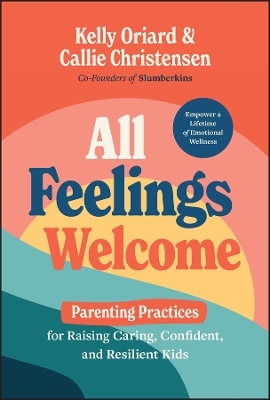
All Feelings Welcome
John Wiley & Sons Inc (Verlag)
978-1-394-22058-8 (ISBN)
In All Feelings Welcome, Kelly Oriard and Callie Christensen, early childhood experts and founders of the Slumberkins brand of characters supporting emotional learning, provide accessible products and tools for empowering kids to build lifelong emotional intelligence. You'll discover how to approach building connections that will have lasting, positive impacts throughout your child's life. Then, you'll follow along with an easy-to-use framework that you can use in your day-to-day to build connection, community, and togetherness—the key ingredients of emotional wellbeing as our kids grow.
Written for parents and caregivers, All Feelings Welcome helps you support children in noticing, naming, and welcoming all feelings through the everyday parenting moments and in the more challenging times when you and your child need support. This book is packed with practical techniques that you can share with all the important people in a child's early emotional learning journey to build confidence and influence their wellbeing for a lifetime.
Support kids' emotional wellbeing by fostering meaningful connections with the adults in their lives
Contribute to a more kind and caring future world by raising children who are in touch with their emotions
Get ideas for helping kids identify, name, accept, and respond to their feelings
Build self-awareness as a parent or caregiver, while supporting the development of a positive self-concept for your child
Parents, caregivers, and anyone with a stake in our kids' futures will love the inspiration and practical tools in All Feelings Welcome.
Kelly Oriard is a mother of two and holds a dual Master’s degree in Marriage and Family Therapy and School Counseling. Callie Christensen is a mother of three and holds a Master’s degree in Teaching with endorsements in Elementary Education and Special Education.
Preface xix
How Slumberkins Was Born xxi
Acknowledgments xxv
Introduction xxvii
Part One The Theory Behind the Connect-to-Grow Approach 1
One Early Emotional Learning Is Foundational 3
The Magic of the Connect-to-Grow Approach 7
Where Does Connect-to-Grow Come From? 8
All Feelings Are Welcome 11
Two Stages of Emotional Development 13
Attachment Relationships 15
What’s Happening in Each Stage and How Our Emotional World Is Shaped 23
Stage 1: Can I Trust the World? 26
Stage 2: Is It OK to Be Me? 31
Stage 3: Is It OK for Me to Try New Things? 34
Stage 4: What Can I Bring to the World? 36
Three Expanding on Core Beliefs 39
Personality Types 44
Why Core Beliefs Are So Important 50
Core Belief Stages 53
Using Core Beliefs to Find Our Inner Voice 56
Four Connect-to-Grow: Breaking Down the Approach 59
Connect 63
Connection to Self for Parents 63
Connection to Self for Kids 65
Connection Between Parent and Child 66
Repair: Returning to Connection 68
Reflect 71
Mirroring and Reflecting: Supporting Your Child’s Feelings, Responses, and Actions 71
What Does Reflection Look Like for Little and Big Kids? 72
Self-Reflection and Modeling 74
Try Modeling Your Own Feelings 76
Practice 77
How Affirmations Support Core Beliefs and the Inner Voice 78
Affirmations That You Can Start Using Today 80
Grow 85
Incorporating Connect-to-Grow in Your Daily Life 86
Before You Start Part 2 . . . 90
Part Two Putting It into Practice 93
Five The Connect-to-Grow Approach in Practice 95
CALM Moments 98
Meet the Characters 101
Six Routines 109
Why Routines Are So Important 112
Routines Through the Ages 112
Proactively Setting Up Routines and Structure 115
Supporting Emerging Independence 117
Affirmation 117
The Bedtime Routine: Implementing Structure and Tools to Support the Process 117
Your Child’s Need for Sleep 119
Affirmation 121
Parent Reflection Moment: Routines 121
Things to Remember 122
Slumberkins Character Connection: Sloth 122
Seven Building Connections 123
Why Connections Are So Important 125
How Children Learn to Connect 126
Proactively Promoting a Sense of Belonging and Building Connections 129
Examples of Healthy Bonding 130
Family Bonding Opportunities 130
Affirmation 131
Recognizing If Your Child Is Struggling 132
Affirmation 133
Parent Reflection Moment: Building Connections 134
Things to Remember 135
Slumberkins Character Connection: Otter 135
Eight Mindfulness 137
Why Mindfulness Is So Important 139
Nurturing Mindfulness in Children 140
Affirmation 143
Using Mindfulness for Stress/Anxiety 143
Supporting Overstimulation and Dysregulation 144
Affirmation 147
Parent Reflection Moment: Mindfulness 148
Things to Remember 149
Slumberkins Character Connection: Yeti 149
Nine Emotional Courage 151
Embracing Emotional Courage 153
Proactively Building Emotional Courage 157
Modeling Emotional Courage 158
Affirmation 159
Supporting a Highly Sensitive or Deeply Feeling Child 159
Affirmation 161
Parent Reflection Moment: Emotional Courage 162
Things to Remember 163
Slumberkins Character Connection: Ibex 163
Ten Gratitude 165
Embracing Gratitude 167
Proactively Promoting Gratitude 170
Shifting Away from Focus on Material Possessions 171
Affirmation 172
Gratitude and Nature 172
Affirmation 174
Parent Reflection Moment: Gratitude 174
Things to Remember 175
Slumberkins Character Connection: Honey Bear 175
Eleven Self-Esteem 177
Nurturing Self-Esteem in Children 179
Teaching Children They Are Loved—and Lovable 181
Proactively Building Positive Beliefs 183
Affirmation 184
Helping a Child Who Is Struggling with Self-Esteem 184
Teach Kids How to Respond 185
Affirmation 186
Parent Reflection Moment: Self-Esteem 187
Things to Remember 188
Slumberkins Character Connection: Bigfoot 188
Twelve Authenticity 189
Exploring Our Authentic Selves 191
Parenting to Proactively Foster Authenticity 194
Affirmation 196
Building Authenticity When You Sense Trouble 196
Understanding the Impact of Spiritual and Cultural Beliefs 198
Affirmation 198
Parent Reflection Moment: Authenticity 199
Things to Remember 200
Slumberkins Character Connection: Unicorn 200
Thirteen Growth Mindset 201
Cultivating a Growth Mindset 203
Proactively Building Growth Mindset 206
Using Constructive Words of Encouragement 207
Words That Reinforce Effort 207
Words That Highlight Potential 208
Words That Foster Curiosity and Learning 208
Words to Avoid 209
Taking Breaks and Why They Are Important 210
Affirmation 210
Helping Shift a Fixed Mindset 211
Teaching Kids How to Respond 211
Affirmation 212
Parent Reflection Moment: Growth Mindset 213
Things to Remember 214
Slumberkins Character Connection: Narwhal 214
Fourteen Self-Acceptance 215
Foster Self-Acceptance 217
Proactively Supporting Self-Acceptance 219
Modeling Self-Acceptance with Your Kids 221
Accept the Things You Cannot Change 221
Encourage Self-Forgiveness 221
Use Positive Affirmations for Self-Compassion 222
Stop Comparing Yourself to Others 222
Practice, Practice, Practice 223
Affirmation 223
How to Support Perfectionism 223
Affirmation 225
Parent Reflection Moment: Self-Acceptance 225
Things to Remember 226
Slumberkins Character Connection: Yak 226
Fifteen Conflict Resolution 227
The Components of Conflict 229
Dealing with Tantrums 231
Focus on Co-regulation 232
Why “Go to Your Room!” Won’t Work 234
Communication During Tantrums 235
Address Destructive Behavior 236
Avoiding Escalation During Outbursts 236
Affirmation 237
Sibling Rivalry 237
Peer Conflict 237
Affirmation 239
Parent Reflection Moment: Conflict Resolution 240
Things to Remember 241
Slumberkins Character Connection: Hammerhead 241
Sixteen Change 243
Supporting Change in Children’s Lives 245
Learning About Family Systems 247
Signs of a Healthy Family System 248
Signs That a Family System Is Not Functioning Well 248
Introducing a New Sibling 249
Understanding a Toddler’s Reaction to a New Sibling 251
Don’t Assume They’re Excited 251
Affirmation 252
Separation and Divorce 252
How to Explain Divorce to Kids 253
Impacts of the Parental Relationship on Children 253
Looking Ahead to Co-Parenting 256
Affirmation 257
Parent Reflection Moment: Change 257
Things to Remember 259
Slumberkins Character Connection: Fox 259
Seventeen Anxiety 261
What If We Reframe Anxiety? 263
Signs of Stress and Anxiety in Children 267
The Dos of Easing Anxiety in Kids 268
The Don’ts of Trying to Easing Anxiety in Children 269
Separation Anxiety 269
You’re Always Connected, Even When You’re Apart 270
Affirmation 271
When to Seek Support 272
Affirmation 273
Parent Reflection Moment: Anxiety 274
Things to Remember 275
Slumberkins Character Connection: Alpaca 275
Eighteen Grief and Loss 277
The Grief Process 279
Proactively Introducing the Concept of Goodbyes 284
Affirmation 285
When You’ve Lost a Loved One 285
10 Facts About Children and Grief 285
How to Talk to a Child About Death 288
Lesson in Supporting Someone Through Grief 288
If Your Child Is Struggling with Grief/Loss 291
Affirmation 293
Parent Reflection Moment: Grief and Loss 293
Things to Remember 294
Slumberkins Character Connection: Sprite 294
Nineteen Self-Expression 295
Expressing Your Needs 297
Proactively Building Self-Expression Skills 300
Affirmation 302
If Your Child Is Struggling with Self-Expression 303
Setting Boundaries 305
Why Setting Boundaries Is Important for Abuse Prevention 306
Help Kids to Know Their Boundaries Through Practicing These Tips at Home 306
Affirmation 308
Parent Reflection Moment: Self-Expression 308
Things to Remember 309
Slumberkins Character Connection: Lynx 310
Twenty Creativity 311
Supporting Creativity 314
Creativity Through the Years 315
Time to Play 317
Affirmation 319
Importance of Imagination in Child Development 319
How to Encourage Imagination in Children 320
Affirmation 322
Parent Reflection Moment: Creativity 322
Things to Remember 323
Slumberkins Character Connection: Dragon 323
Use Case Guide 325
Index 331
| Erscheinungsdatum | 21.08.2024 |
|---|---|
| Verlagsort | New York |
| Sprache | englisch |
| Maße | 163 x 231 mm |
| Gewicht | 612 g |
| Themenwelt | Sachbuch/Ratgeber ► Gesundheit / Leben / Psychologie ► Familie / Erziehung |
| Geisteswissenschaften ► Psychologie ► Entwicklungspsychologie | |
| Geisteswissenschaften ► Religion / Theologie | |
| Sozialwissenschaften ► Pädagogik ► Schulpädagogik / Grundschule | |
| Sozialwissenschaften ► Soziologie | |
| ISBN-10 | 1-394-22058-8 / 1394220588 |
| ISBN-13 | 978-1-394-22058-8 / 9781394220588 |
| Zustand | Neuware |
| Haben Sie eine Frage zum Produkt? |
aus dem Bereich


